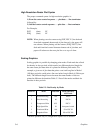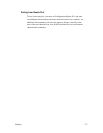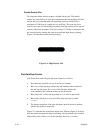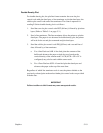Graphics5–12
Bit Image Programming Format
The Bit Image command format is:
ESC CC(n1)(n2)DATA where:
ESC = the Proprinter compatible header
CC = K, L, ,Y or Z to select dot density
(K=single, L=double, Y=single, Z=double)
n1, n2 = n1+ 256(n2) defines the number of data bytes
DATA = the dot pattern bytes
Refer to the following guidelines when using the Bit Image Programming
Format:
• The syntax of the bit image expression must be correct.
• The expression must include the appropriate dot density control code,
the number of bytes of data to be plotted, and the data itself.
• The number of data bytes and the n1, n2 definition must be equal.
• Any characters following n1 and n2 will be interpreted and plotted as
data until the n1, n2 definition is satisfied.
• If n1 = n2 = 0, then control codes K, L, Y, or Z are ignored:
n2 = 2(700/256) = 700
bytes of data; 2 sets of 256 with a 188 remainder
n1 = 188 = 188–byte remainder
The program statement is: ESC K(188)(2)(DATA)
NOTE: Depending on the host computer system, it may be necessary to
include a width statement within the BASIC program.
• The maximum number of data bytes in the DATA portion of the
program statement (when using 132–column paper) varies according to
the operating mode:
At 60 dpi, Single Density = 792 bytes
Double Density = 1584 bytes
• Data in excess of the right margin is discarded. If the auto line feed is
enabled, data in excess of the right margin causes a Line Feed (LF) and
continue printing on the next line.


















